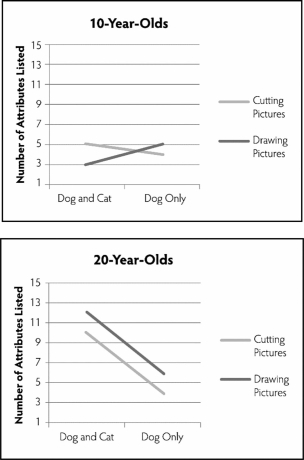(The first paragraph is repeated from earlier.The second paragraph is specific to the new set of questions.The first paragraph is necessary to set up the original study. )
Dr.Elder was interested in the way people recognize objects as members of categories.For example,what makes us recognize a dog as being a dog and not a cat? More specifically,he was curious as to whether people think about categories in a more complex way if they contemplate an "opposite" category first.For example,does a person think more differently about the category of "southern" if they are also thinking about the category of "northern"? He is also curious as to whether people categorize differently if they are exposed to category members compared with generating category members.Dr.Elder has four groups of participants (with 30 people in each group) .In Group A,participants were told to cut out pictures of dogs and cats from magazines.In Group B,participants were told to cut out pictures of just dogs from magazines.In Group C,participants were told to draw pictures of cats and dogs.In Group D,participants were told to draw pictures of just dogs.After doing this for 30 minutes,participants in all groups were asked to list the attributes that define the "dog" category.Having a higher number of attributes listed was considered to be an indication of thinking about the category in a more complex way.
Dr.Elder also is curious as to whether categorization happens similarly for children as it does for adults.As such,he recruits a group of 10-year-olds and a group of 20-year-olds to participate in the study.The results are below.

-The addition of the new variable to Dr.Elder's study could be thought of as which of the following?
Definitions:
Structural Changes
Alterations or transformations in the organizational, economic, or social structure of a system or society.
Caregiving Responsibilities
Obligations related to the care of dependents, such as children, elderly family members, or individuals with disabilities, often requiring time, emotional, and financial resources.
Canadian Society
A complex set of cultural, social, and economic structures and practices specific to Canada, shaped by its history, geography, and diverse population.
Public Arena
A metaphorical space where ideas, policies, and issues are publicly debated and discussed, influencing public opinion and decision-making.
Q1: Your professor says that researchers do not
Q6: Dr. White reads about a new theory
Q10: How can you ensure that a popular
Q17: Your friend Dominic is complaining about having
Q21: Which of the following is a poll
Q33: Which of the following could be an
Q36: A study finds a correlation coefficient of
Q47: Why are techniques like cluster sampling and
Q48: Dr. Mendoza sends a paper to a
Q62: Which of the following is a reason